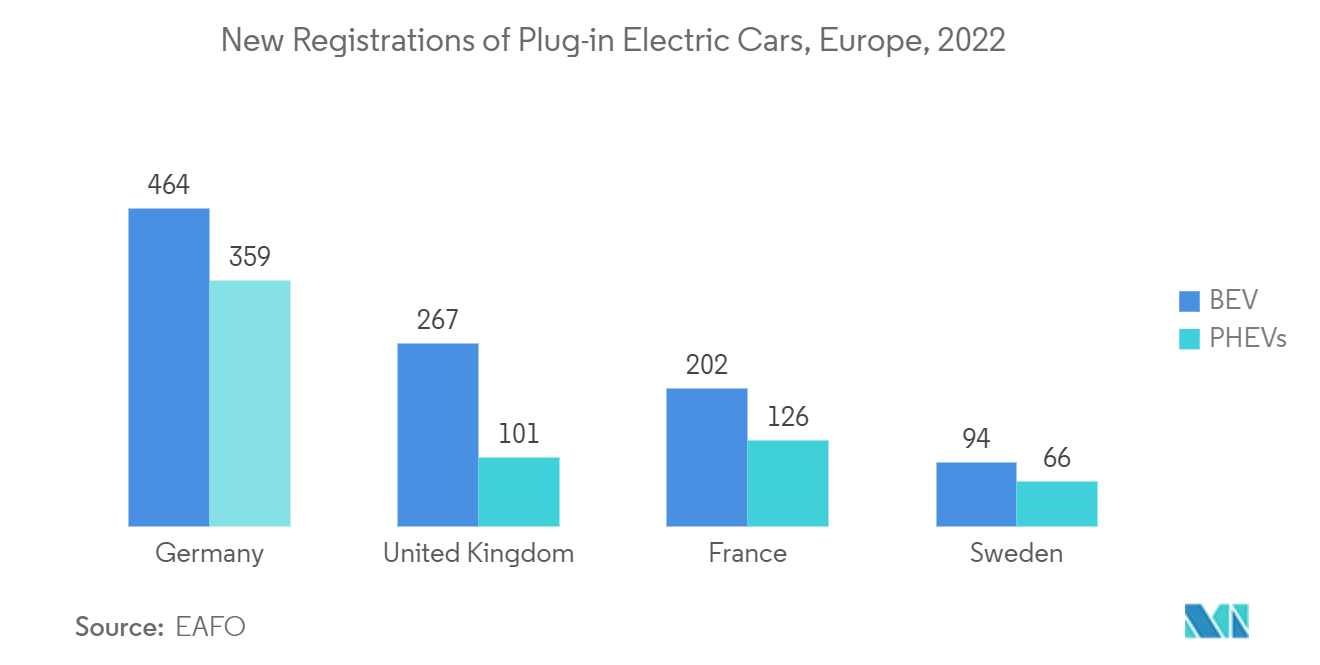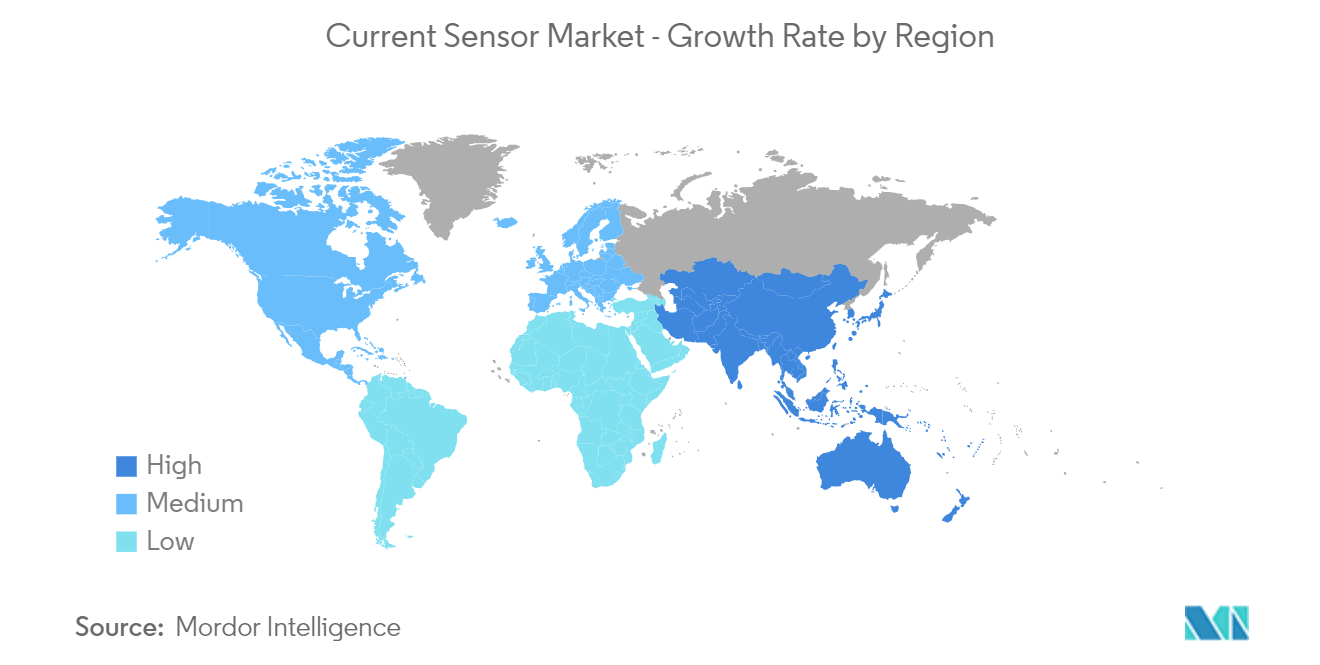Market Trends of Current Sensor Industry
Automotive Industry to Hold Considerable Market Share
- With increased automotive technology advancements, the trends toward electric vehicle production are highly recommended in various countries. A complex architectural diagram of an electric car generally incorporates multiple current sensors. Besides this, current sensors are also needed for brushless (BLDC) electric motor control. The EVs (electronic vehicles) of companies like BMW, Volkswagen, etc. use this motor-control-current device.
- Typically, current sensors are found in battery current monitoring, solar power inverters, and power inverters that drive traction motors in mid and full hybrid electric vehicles. CMOS Hall-effect-based magnetic sensors integrate advanced features and provide high-level output signal functionality. Sophisticated magnetic sensors hold programmable memory, and even microcontroller logic allows for a fully custom-calibrated output. Additionally, it is possible to implement standard interfaces that simplify communication with other circuits in EVs.
- Furthermore, the hybrid electric vehicle (HEV) is quickly becoming the most popular green car and employs complex electronic circuitry to control the flow of electric energy through the vehicle. In a single-motor HEV, the motor acts as a drive motor in parallel with the internal combustion engine or as a generator to charge the battery during regenerative braking. A typical HEV includes multiple systems that require electrical current detectors for maximally efficient operation, including AC motor and DC-DC converter applications. According to the European Alternative Fuels Observatory (EAFO), Germany recorded 823,900 new registrations of plug-in electric cars in the passenger car segment in 2022, with battery electric vehicle (BEV) sales accounting for about 56.36 percent.
- Players like Allegro MicroSystems have developed a broad family of current sensor integrated circuits (ICs) that are ideally suited for hybrid electric vehicles (HEV) applications. The features include signal processing and package design innovations enabling 120 kHz output bandwidth, high current resolution, low noise spectral density, reduced power loss through-hole compliance, and low-resistance integrated conductor packages. Further, in November 2022, Infineon launched an automotive current sensor IC (TLE4971), available in four pre-programmed current ranges: 25, 50, 75, or 120 A. The TLE4971 is intended for onboard chargers, high-voltage auxiliary drives, and charging applications. Moreover, the sensor is also suitable for industrial applications like DC chargers for electric vehicles, industrial drives, servo drives, and photovoltaic inverters.
- Favorable government regulations are also playing an integral role in the growth of the EV industry, which has emerged as a leading consumer of current sensors. For instance, in early 2022, the European Union announced a unique EUR 750 billion (USD 770.5 billion) stimulus package, which includes EUR 20 billion (USD 20.5 billion) to boost the sales of clean vehicles and to install about 1 million electric and hydrogen cars charging stations by 2025.
- To stimulate the growth of the Chinese automotive industry, several initiatives are also being taken by the government. For instance, in September 2022, the State Taxation Administration (STA), the Ministry of Finance (MOF), and the Ministry of Industry and Information Technology (MIIT) jointly announced the continuation of tax exemptions on purchases of new energy vehicles. Hence, with the sales of EVs expected to sustain a similar growth pattern, the demand for current sensors across the country's automotive industry is also expected to grow further during the forecast period.
- Additionally, in October 2022, The BMW Group confirmed the investment of USD 1.7 billion in its American facilities to produce electric automobiles and batteries. The project will consist of USD 700 million for a planned high-voltage battery-assembly plant in the neighboring Woodruff and USD 1 billion to equip the automaker's current Spartanburg manufacturing in South Carolina for the manufacturing of EVs. By 2030, the German manufacturer plans to manufacture at least six all-electric vehicles in the United States.

Asia-Pacific is Expected to Register Significant Growth
- Asia-Pacific is anticipated to account for significant growth. The population growth and rapid urbanization in developing economies, such as India, China, and Japan, have initiated the speedy expansion in the region, which will increase the need for the current sensor from end-users such as energy, automotive, telecom and networking, industrial, and healthcare. According to IEA, an estimated 270 million people will likely be added to India's urban population by 2040. As urbanization leads to a rise in the ownership of consumer appliances, the share of energy demand taken by electricity is expected to grow further.
- According to the Consumer Electronics and Appliances Manufacturers Association, India's appliances and consumer electronics industry is projected to double by INR 1.48 lakh crore (USD 17.9 Billion) by 2024 - 25. As players are manufacturing fully integrated and programmable current sensors based on BiCMOS or CMOS technology, the demand for these current sensors will increase effectively with the increasing production of consumer electronics.
- The Japanese government is also investing significantly in developing renewable industry infrastructure. To achieve its net zero by 2050 plans, the government has launched several initiatives worth multiple billions. Hence, the growing investment in renewable energy infrastructure will drive the demand for current sensors in the country during the forecast period.
- Furthermore, China, responsible for a large portion of global car consumption, pledged to control its carbon emissions by 2030. It has been streamlining the production cuts and sale of cars that run on fossil fuels to meet the emission goals. This is anticipated to increase the demand for electric vehicles, thereby driving market growth. According to the International Council on Clean Transportation (ICCT), throughout the first six months of 2022, electric vehicles in China constituted almost one-fourth of all unique passenger car registrations, with BEVs accounting for 19 percent and PHEVs an additional 5 percent.
- The Australian government has started taking several initiatives to expand the production of renewable power in the country. The government seeks to achieve net zero carbon emissions by 2050, which is expected to create significant opportunities for the studied market vendors. For instance, in October 2022, the Australian government allocated a budget of AUD 25 billion (USD 16.7 billion) for cleaning energy spending and renewable energy projects. Furthermore, the government also launched an AUD 20 billion (USD 13.4 billion), rewiring the Nation's plan to modernize the country's electricity grids.
- Furthermore, in recent years, Taiwan has emerged as the leading semiconductor chip manufacturer and has even outpaced China in some categories. Driven by the semiconductor industry's growth, the consumer electronics industry of the country has also started to gain traction, with companies like Asus and HTC making their place in the global consumer electronics industry.

